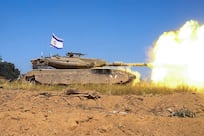With his waxen features, protruding ribs, sparrow's legs and matchstick arms, Jimmy Wilde looked as though he should have been slouching droop-shouldered across a Lowry industrial landscape instead of fighting like a whirling dervish on a boxing canvas. Barely 1.6m tall and seldom weighing more than 44.5kg, Wilde surrendered height and weight to almost every one of his 864 ring opponents (aye, they bred them tough in those days) yet was hailed as the "greatest flyweight ever" by American promoter "Broadway" Charley Rose.
Indeed, although Monday marked the 40th anniversary of his death, many still consider the "Mighty Atom" to be the finest pound-for-pound fighter of them all. Such was the ferocity of his punching power that Ring Magazine named the tiny Welshman at No 3 in their "100 Greatest Punchers" list behind Joe Louis and Sam Langford, but ahead of such noted human missile launchers as Archie Moore, Jack Dempsey, George Foreman, Earnie Shavers, Rocky Marciano and Mike Tyson.
Born into poverty on May 15 1892 in Merthyr Tydfil, Wilde began work at the age of 12, chiselling coal from shafts too narrow for a grown man to squeeze through; by 16, he had become a legend in the Rhondda Valley via his prowess against all-comers in Jack Scarrott's boxing booth. Wilde was credited with more than 700 victories in those early days, frequently beating 25 opponents - all of whom would routinely outweigh him by 20kg and more - in a day.
Though possessed of lightning-quick hands and dizzying speed of foot, the power Wilde could generate from his scrawny frame intrigued ring experts throughout his career and he became the subject of a series of medical examinations as doctors sought a scientific answer to his seemingly inhuman strength. Others put it down to his often weird and wonderful training methods which included sparring with his wife Elizabeth.
With Lizzie Wilde's help, her husband was proclaimed world champion in Britain following his victory over Joe Symonds on Feb 14 1916 but the Americans were less enamoured and withheld recognition until his 11th-round knockout of Young Zulu Kid 10 months later. Having served as a company sergeant major in the First World War - as a PE instructor in Aldershot he boxed only five times in the years 1917-18 - Wilde made his long-awaited return to the ring against American Joe "Irish" Lynch at the National Sporting Club in Covent Garden on March 31 1919, when a crowd of 10,000 defied the heavy rain lashing the streets of London to stand outside awaiting the announcement of the result over the public address system.
As a ringside scribe of the day described Wilde's bloody and bruising 15-round victory: "It was one of the most wonderful battles ever decided in the historic club and undoubtedly the greatest seen between two little men." After a 12-month tour of the US - where future world heavyweight champion Gene Tunney said of him: "He is the greatest fighter I've ever seen..." - Wilde took the title into retirement for more than two years before making a misguided comeback at the age of 31 against Filipino Pancho Villa, nine years his junior, in the Polo Grounds, New York amid controversial circumstances; when the bell sounded to end round two, the ex-champ dropped his guard and was poleaxed by a late punch.
Unable to see out of either eye, he fought on with foolhardy courage before being knocked out in the seventh round, only his fourth defeat in 149 pro contests. He died at the age of 76, a broken man who never fully recovered from being beaten up by a gang of teenagers on a lonely railway station platform. But the legend of Jimmy Wilde will live forever... @Email:rphilip@thenational.ae




